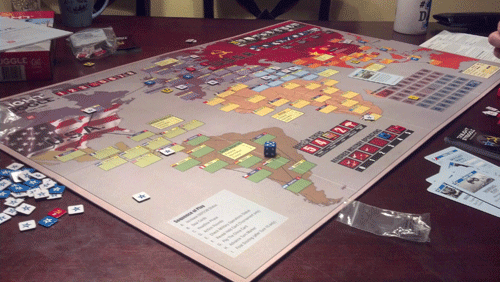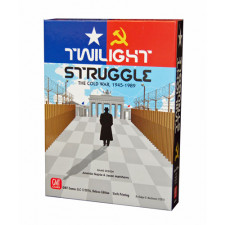Twilight Struggle (2016 Edition) Review
on Dec 29, 2016
The challenge in making a good game about the Cold War is that it wasn’t really a war at all, but rather a high-stakes staring contest. The two major players, the U.S. and the U.S.S.R., primarily vied for power and influence through passive aggression and indirect conflict by proxy. That’s not to say there wasn’t fighting over territory as in most historical conflicts; there most certainly was. But at the heart of the “war†was the struggle between two competing ideologies, who pushed agendas that had unforeseen consequences for decades to come.
How do you represent this in a cardboard simulation, then, when wargamers are used to pushing around tanks and planes, with the best tactician routing the enemy from the battlefield? The answer for the designers of Twilight Struggle was to make every action a double-edged sword, thereby tasking players with making plays with the intention of minimizing the damage their opponent would do right back to them after their move.
Twilight Struggle is an amazing game, not because it’s a perfect historical simulation, but because it forces players to make the same kinds of tense decisions that global superpowers were faced with throughout the series of conflicts worldwide. No, you’re not managing a massive army or amassing troops to initiate advantageous battles when the time is right. Instead, you’re staring at a hand of cards that can all do tremendous damage to your cause, and your job is to find the best way forward without sinking your chances.

People who complain about the purported lack of logic in being forced to play your opponent’s events have missed the point entirely. That is the beauty of the system: everything has an opportunity cost. You may get a leg up on your foe in Europe, but perhaps that gives him or her a chance to pull off a sinister plot in the Middle East. You may fire off a major coup in Asia, but while your sights are set to the Far East, you’ve offered your enemy precious time to meddle in the affairs of volatile South American countries.
It makes for a fascinating gaming experience. There are no perfect plays, since you’re always setting your opponent up for a devastating riposte. Your job is to just minimize the hurt and maximize your own opportunities, while pushing and pulling the conflict into the continents that you think will score next.
So yes, on one level, it’s a little gamey. You’re fighting the system, and not necessarily making the kinds of nut and bolt decisions a Soviet or American political leader would have been faced with during the ‘60s or ‘70s. You’re playing a card game, tallying up the results on a world map, and hoping you come out on top when the scoring cards hit the table.
But at the same time, the effect generated by the system is acceptably faithful to the conflict, and perhaps more importantly, creates a huge space for clever play, interesting decisions, and a dynamic narrative. The two superpowers clash over territories worldwide, subtly influencing policy and propping up leaders when convenient, until the conflict boils over into neighboring countries as the two opponents duel all over the globe. At the same time, the threat of plunging the world into an apocalyptic nuclear winter is a very real one, as players struggle to keep the conflict from bubbling over into full-scale nuclear war.
What’s even more impressive is that this all happens in a very streamlined, easy-to-learn design. There is bottomless strategic depth for those interested enough to learn the card decks and grapple with the implications of the rule set, and yet it all occurs with low rules overhead. There are few exceptions or wonky rules that buck the trend, and within a few turns, players will never have to reference the rule book or wonder how a particular card is supposed to work. All the flavor and dynamics of the design happen within the simple rule structure, with the event cards providing the quasi-historical narrative against the backdrop of the Cold War.
Twilight Struggle is one of the greatest games ever designed, without question. It melds historical authenticity with clever, unique gameplay in equal measure, and most importantly, it makes you feel as though the fate of the world truly is in your hands with each brutally difficult decision that you’re forced to make.

 Customer Support
Customer Support  Subscribe
Subscribe 




 Account
Account  Wishlist
Wishlist 

